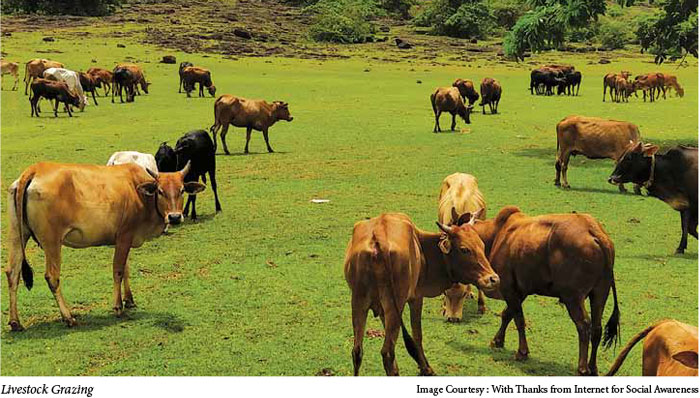
Animal Welfare is a key to Resilient Development
By Shivraj Sharma
According to Indian Epic Mahabharata – Swargarohana Parva, when mighty Pandavas renounced their Kingdom and began the ascent of Meru hill in Himalaya for their final journey. King Yudhisthir led the way followed by Bheem, Arjun, Nakul, Sahadev and Draupadi.
A dog also accompanied them through out their journey. When all Pandavas fell one by one from their sorrows the faithful dog kept the company of King Yudhisthir. At the gate of heaven, the keepers allowed King Yudhisthir to enter but not the dog, to which King Yudhishtir took objection and politely refused to enter heaven saying the dog sought his help and gave him his unconditional love therefore he can not enter the heaven if the dog is not allowed. With his refusal to enter the heaven, the dog transformed into God Dharma (Lord Yama) who was testing his understanding of goodness among all living beings. Coming to Indian history, Panchatantra – a collection of interrelated animal fables in Sanskrit was developed around 200 BC -300 BC. It is a classical literature of India that has been most frequently translated in other languages across the world. There are interlinked fables which employed metaphors of animal with human virtues. Further coming to relatively recent history of India, every time there is a reference to the battle of Haldighati, it can not be complete without the mention of mighty Horse – Chetak who despite being wounded and dying still managed to carry Maharana Pratap to safety.
The list of such references goes on where animals have been one of the most admirable factors in development of civilization. Their contribution is increasing with the population increase at the same time it has been supporting the human settlements on various aspects of sustenance and development. The stronger synergy is the key to resilient development.
As per the 20th livestock census 2019, the total livestock population has increased 4.6 percentage from the last livestock census which now stands at 536.76 million in the country. Notable statistic is the livestock percentage increase in urban area which is 11.19 percentage compared to rural area which is 4.56 percentage. This further confirms the closer links of animals to humans. They have been contributing to many sectors such as transportation, dairy, tannery, food, agriculture, fertilizer etc. Therefore, it is crucial to understand the need for their safety and sustainability. Contribution of livestock sector has been increasing steadily in the GDP of India as shown in the chart below:
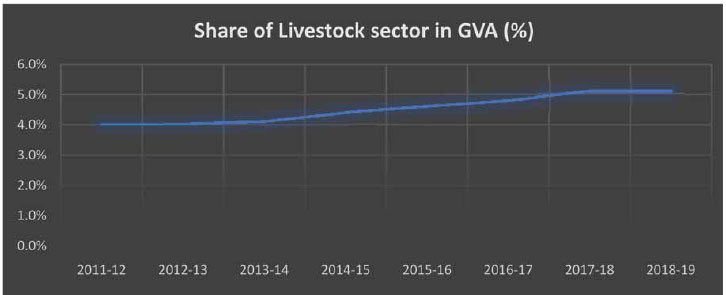
In case of Madhya Pradesh, it has more than 70 percent human population from rural area primarily depends on agriculture and allied sector where animal husbandry becomes important. In the year 2012, the cattle population in the state was 36.3 million which increased to 40.6 million (11.81 percent increase) which places Madhya Pradesh being the third largest state in the country after Uttar Pradesh and Rajasthan. There has been significant increase in milk production from the state which approximately 8.5 percent of the country. It is the third highest in the country after Uttar Pradesh and Rajasthan. The production of milk has increased up to 200 percent in the year 2018-19 from 2001-02 as shown in the chart below:
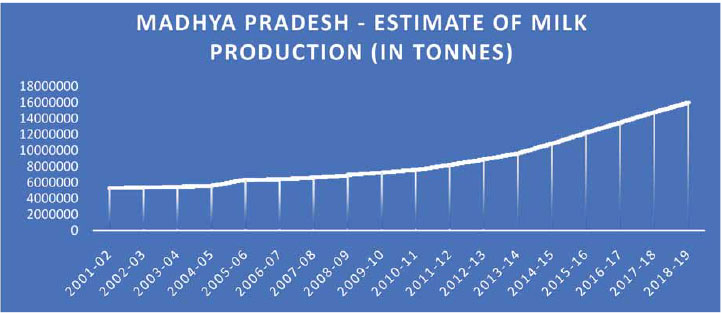
However, situation becomes complex during and after natural disasters when there is a dire need for animal welfare. Their survival and continued welfare are responsibility that needs to be holistic, inclusive and integral part of any development plan. Quite often, when there is a consideration on loss of human lives, sometimes the loss of cattle does not highlight the indirect impact to development. However, as we are aware, climate change and disaster affect all and the same can be observed through the chart shown below:
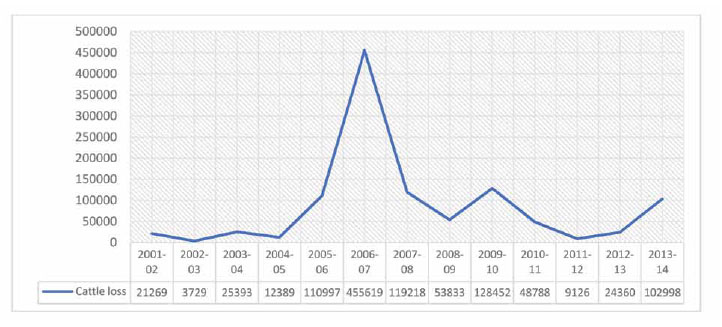
According to the Annual Report 2014 by Ministry of Home Affairs, the data from chart for cattle perished has always remained higher than the loss of human lives.
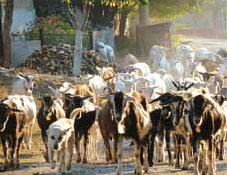
Madhya Pradesh, despite being landlocked state, has complex multi-hazard scenario with now ever-increasing threat of climate change can pose serious challenge to animals in the state. According to Relief Commissioner, Madhya Pradesh, from 2005-06 onwards 34 districts have experienced floods as well as drought and 46 districts (out of 52 districts) have been affected by at least one disaster. The state had witnessed animal loss of 1,888 and 1,332 in the year 20018-19 and 2019-20 respectively. These numbers are higher than lost of human lives reported making the cattle vulnerable. Therefore, it is vital to integrate animal welfare into climate and disaster resilience.
Ministry of Agriculture and Farmers Welfare, GoI came up with Disaster Management Plan in 2016 for protecting animals and preventing & mitigating loss of cattle during disaster. The purpose of the disaster management plan was to supplement the ongoing efforts made by states on protection of animals during disasters.
The consequences of climate change increase the risk of natural disasters occurring and amplify impacts of natural disasters. As most of the state’s population rely on cattle for food security and livelihoods, protecting animals from the effects of climate change induced natural disasters must be an essential part of any effective disaster response. Integrating animal welfare into disaster risk reduction, climate resilience and preparedness planning will significantly reduce suffering, facilitate and accelerate recovery and limit post-disaster aid dependency.
Animal welfare is a critical component for achieving resilient development. Animals are required to be identified as one of the vulnerable groups as they are crucial link to livelihood of millions across the globe, biodiversity, agriculture, dairy and integral to climate change adaptation strategy. They must be included in the planning and preparedness process for risk governance. Thus, for resilient development, animal welfare needs to be inclusive, sustainable, risk informed and integral part of mainstream development governance.




